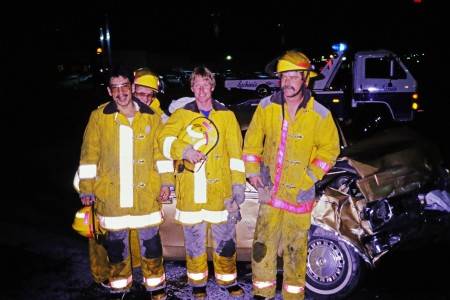NEAR DROWNING
ALL LEVELS
DESIGNATION OF CONDITION
Includes a history of being submerged under water for an excessive period of time resulting in potential cardiopulmonary compromise. Mitigating circumstances include shockable rhythm, inconclusive history of immersion, uncertain water temperature.
EMPHASIS ON PATIENT CARE
1. Primary Management - Assess ABC’s and manage as indicated.
2. Begin artificial respirations in the water, taking C-spine precautions. Stabilize C-spine prior to moving from water if any suspicion of a potential head or neck injury exists.
3. If hypothermia is present or suspected, refer to Hypothermia Treatment Guidelines.
4. If water temperature is < 6°C (43°F) and submerged;
a. <90 minutes: full resuscitation
b. >90 minutes: do not initiate resuscitation unless mitigating circumstances
5. If water temperature is >6°C (43°F) and submerged:
a. <30 minutes: initiate full resuscitation
b. >30 minutes: do not initiate resuscitation unless mitigating circumstances
6. Secondary Management - History, physical exam, vital signs
a. History of incident including:
i. How long was patient submerged?
ii. Fresh, polluted or salt water
iii. Diving accident (suspect C-spine injury)
iv. Water temperature
v. Pre-existing medical conditions
AEMT
1. In-route, initiate a large bore IV/IO of an isotonic solution and infuse at a flow rate to maintain adequate end organ perfusion.
2. If cardiac arrest occurs, follow Medical Cardiac Arrest Treatment Guidelines.
PARAMEDIC
1. ECG monitor
2. Monitor patients' vital signs and continue to reassess
3. Transport to appropriate facility
ALL LEVELS
DESIGNATION OF CONDITION
Includes a history of being submerged under water for an excessive period of time resulting in potential cardiopulmonary compromise. Mitigating circumstances include shockable rhythm, inconclusive history of immersion, uncertain water temperature.
EMPHASIS ON PATIENT CARE
1. Primary Management - Assess ABC’s and manage as indicated.
2. Begin artificial respirations in the water, taking C-spine precautions. Stabilize C-spine prior to moving from water if any suspicion of a potential head or neck injury exists.
3. If hypothermia is present or suspected, refer to Hypothermia Treatment Guidelines.
4. If water temperature is < 6°C (43°F) and submerged;
a. <90 minutes: full resuscitation
b. >90 minutes: do not initiate resuscitation unless mitigating circumstances
5. If water temperature is >6°C (43°F) and submerged:
a. <30 minutes: initiate full resuscitation
b. >30 minutes: do not initiate resuscitation unless mitigating circumstances
6. Secondary Management - History, physical exam, vital signs
a. History of incident including:
i. How long was patient submerged?
ii. Fresh, polluted or salt water
iii. Diving accident (suspect C-spine injury)
iv. Water temperature
v. Pre-existing medical conditions
AEMT
1. In-route, initiate a large bore IV/IO of an isotonic solution and infuse at a flow rate to maintain adequate end organ perfusion.
2. If cardiac arrest occurs, follow Medical Cardiac Arrest Treatment Guidelines.
PARAMEDIC
1. ECG monitor
2. Monitor patients' vital signs and continue to reassess
3. Transport to appropriate facility
